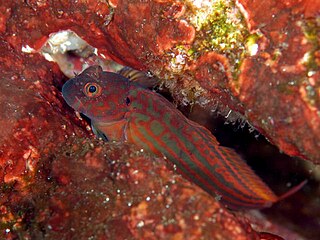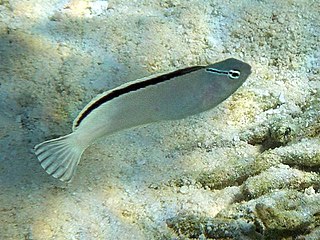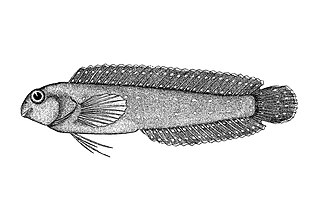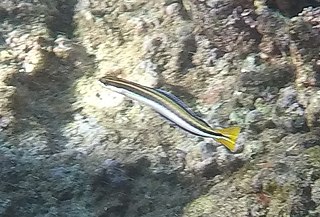
The Pacific leaping blenny, also known as the leaping rockskipper, is a species of combtooth blenny in the genus Alticus. The blennies are oviparous, and form distinct pairs when mating. Males can reach a maximum total length of 8 centimetres. These fish feed primarily on benthic algae, which they consume by scraping off rocky surfaces.

The Kirk's blenny is a species of combtooth blenny in the genus Alticus. It was described by A. Günther in 1964, originally as a member of the genus Salarias. It is a tropical blenny which is known from the Red Sea, Mozambique, Réunion, the Persian Gulf, and India, in the Indian Ocean. Kirk's blennies inhabit waters near the shore, and often spend time out of the water. They are able to breathe air when on land. They are oviparous, and form distinct pairs when mating; they also guard their eggs.

Cirripectes kuwamurai is a species of combtooth blenny found on rocky and coral reefs in the northwest Pacific ocean off Japan. This species reaches a length of 5.5 centimetres (2.2 in) SL. The specific name honours the Japanese fish ecologist Tetsuo Kuwamura who collected the type.
Cirripectes springeri, Springer's blenny or the spotted eyelash blenny, is a species of combtooth blenny found in coral reefs in the western Pacific Ocean. This species reaches a length of 10 centimetres (3.9 in) TL. The specific name honours the American ichthyologist Victor G. Springer of the United States National Museum who has worked extensively on blennies.

Hypsoblennius invemar, commonly known as the tessellated blenny, is a species of combtooth blenny found in the western Atlantic Ocean.

Istiblennius dussumieri, the streaky rockskipper, is a species of combtooth blenny found in coral reefs in the western Pacific and Indian Oceans. It is also commonly known as the Dussumier's rockskipper, streaky dussumier, or the Dussumier's blenny.

Meiacanthus kamoharai is a species of combtooth blenny found in coral reefs in the western Pacific ocean, around southern Japan. This species grows to a length of 6 centimetres (2.4 in) TL.

Meiacanthus smithi, the disco blenny, is a species of combtooth blenny found in coral reefs in the eastern Indian Ocean. This species grows to a length of 8.5 centimetres (3.3 in) TL. It is also commonly known as Smith's fangblenny, Smith's sawtail blenny or Smith's harp-tail blenny. This species is also found in the aquarium trade.
Omobranchus woodi, the kappie blenny, is a species of combtooth blenny found in the southeast Atlantic and western Indian Ocean.
Parablennius goreensis is a species of combtooth blenny found in the eastern Atlantic ocean. This species reaches a length of 7 centimetres (2.8 in) SL. The specific name refers to the type locality, Gorée, in Senegal.

The Yatabe blenny is a species of combtooth blenny found in the northwest Pacific Ocean along the coasts of southern Japan and Korea. This species reaches a length of 9 centimetres (3.5 in) TL. The specific name was coined in memory of Jordan and Snyder's friend and fellow alumnus at Cornell University the botanist Riokichi Yatabe [1851-1899] who drowned in an accident while on holiday in Japan.

Parenchelyurus hepburni, Hepburn's blenny or the bluespotted blenny, is a species of combtooth blenny found in coral reefs in the Pacific and Indian Ocean.
Petroscirtes thepassii, the Thepas' sabretooth blenny or the Thepas' fangblenny, is a species of combtooth blenny found in the western central Pacific ocean. This species reaches a length of 5.9 centimetres (2.3 in) SL. The specific name of this blenny honours the collector of the type, the military surgeon A.H. Thepass.

Plagiotremus goslinei, the biting blenny, Gosline's fangblenny, scale-eating blenny or the scale-eating fang blenny, is a species of combtooth blenny found in coral reefs in the eastern central Pacific Ocean. This species reaches a length of 6.3 centimetres (2.5 in) SL. The specific name honours the American ichthyologist William A. Gosline (1915-2002) of the University of Hawaiʻi.
Rhabdoblennius snowi, Snow's rockskipper or the Snow blenny, is a species of combtooth blenny found in coral reefs in the Pacific ocean. This species reaches a length of 7 centimetres (2.8 in) TL. The specific name of this blenny honours the collector of the type, the missionary Benjamin Galen Snow (1817-1880).

Salarias patzneri, Patzner's blenny, is a species of combtooth blenny found in coral reefs in the western central Pacific ocean. This species can reach a length of 5.5 centimetres (2.2 in) TL. The specific name honours the Austrian ichthyologist Robert A. Patzner who worked on the genitalia of blennies and who shared specimens with Hans Bath.

Ecsenius schroederi, known commonly as the Schroeder's combtooth-blenny in Indonesia, is a species of combtooth blenny in the genus Ecsenius. It is found in coral reefs in the western Pacific ocean, specifically in Indonesia. It can reach a maximum length of 7 centimetres. Blennies in this species feed primarily off of plants, including benthic algae and weeds, and are commercial aquarium fish. The species was named in honour of the wildlife artist and scientific illustrator Jack R. Schroeder (1954-2004).

Stanulus talboti, Talbot's blenny, is a species of combtooth blenny found in coral reefs in the western Pacific Ocean. This species feeds primarily on plants, including benthic algae and weeds. This species can reach 4.8 cm (1.9 in) in TL. This fish is also found in the aquarium trade.
Cirripectes heemstraorum, the yellowtail blenny, is a species of combtooth blenny from the family Blenniidae. It is found in the Indian Ocean where it is known from three South African specimens and an Indonesian specimen. It is distinguished from its congeners by the nape having an extensive black flap on both sides of its neck; 10-13 cirri which are found between the neck flaps; an entire dorsal fin; 5-6 cirri above the eye, 6-8 cirri on the nose; the males have small dark spots on their body towards the tail which merge to form short black stripes on caudal peduncle, in life the females have a brilliant yellow caudal fin while in the males only the outer half of the tail is bright yellow.
Hypleurochilus brasil is a species of combtooth blenny from the subfamily Salarinae of the family Blenniidae. It is endemic to the reefs around Trindade and Martin Vaz off Brazil in the western South Atlantic Ocean.













